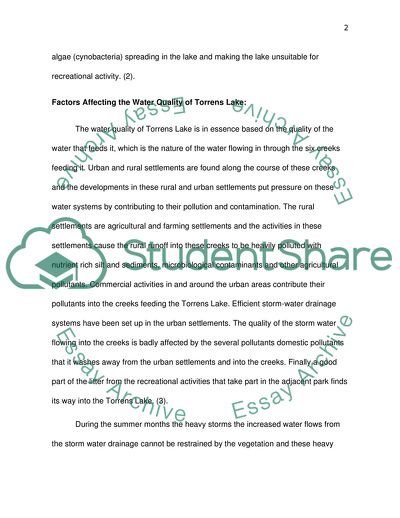
- Home
- Free Samples
- Premium Essays
- Editing Services
- Extra Tools
- Essay Writing Help
- About Us
- Studentshare
- Subjects
- Miscellaneous
- WATER QUALITY PROCESSES
WATER QUALITY PROCESSES - Essay Example

- Subject: Miscellaneous
- Type: Essay
- Level: Ph.D.
- Pages: 4 (1000 words)
- Downloads: 0
- Author: roma19
Extract of sample "WATER QUALITY PROCESSES"
t area of more than five hundred square kilometers, along with its components of Torrens Lake and Linear Park make up a significant natural resource along its course till it leads into the seas through the Break Water Creek. (1). The Torrens Lake was created by the construction of a weir on the Torrens River in 1881. The surface area of the Torrens Lake is approximately 500 ha, with water depth ranging from 3 to 6 meters. Water flows into the Torrens Lake from six upstream creeks. This natural resource is getting polluted through human activity of agriculture and the consequences of urban and rural activities along the banks of the inflowing creeks and its banks, reducing the potential utility of this natural resource.
The reduction in water quality has led to blooms of blue-green algae (cynobacteria) spreading in the lake and making the lake unsuitable for recreational activity. (2). The water quality of Torrens Lake is in essence based on the quality of the water that feeds it, which is the nature of the water flowing in through the six creeks feeding it. Urban and rural settlements are found along the course of these creeks and the developments in these rural and urban settlements put pressure on these water systems by contributing to their pollution and contamination.
The rural settlements are agricultural and farming settlements and the activities in these settlements cause the rural runoff into these creeks to be heavily polluted with nutrient rich silt and sediments, microbiological contaminants and other agricultural pollutants. Commercial activities in and around the urban areas contribute their pollutants into the creeks feeding the Torrens Lake. Efficient storm-water drainage systems have been set up in the urban settlements. The quality of the storm water flowing into the creeks is badly affected by the several pollutants domestic pollutants that it washes away from the urban settlements and into the creeks.
Finally a good part of the litter from the
...Download file to see next pages Read More
- TERMS & CONDITIONS
- PRIVACY POLICY
- COOKIES POLICY